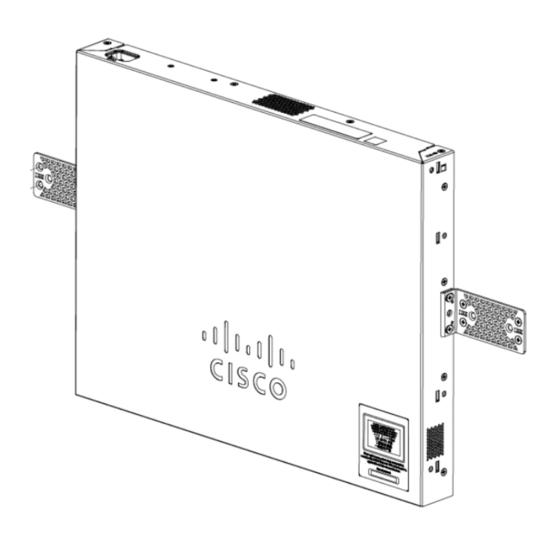
Advertisement
Get to Know Your Switch
This chapter contains the following sections:
•
•
•
•
•
•
Introduction
Thank you for purchasing the Cisco CBS 220 Series Switch. The Cisco CBS 220 Series Switches are the next
generation of affordable smart switches that combine powerful network performance and reliability with a
complete suite of network features that you need for a solid business network. These expandable Gigabit
Ethernet switches, with Gigabit or 10-Gigabit uplinks, provide multiple management options, and rich security
capabilities. With an easy-to-use web user interface and Power over Ethernet Plus capability, you can deploy
and configure a complete business network in minutes.
Before You Begin
Before you begin installing your device, ensure that the following items are available:
• RJ-45 Ethernet cables for connecting network devices. A category 6a and higher cable is required for
• Tools for installing the hardware.
Introduction, on page 1
Rack Mounting Switch, on page 2
Wall Mounting a Switch, on page 3
PoE Consideration, on page 5
Front Panel, on page 6
Configuring Switches, on page 8
10G ports; a category 5e and higher cable is required for all other ports.
• The rack-mount kit packed with the switch contains four rubber feet for desktop placement, and
two brackets and twelve screws for rack mounting.
• If the supplied screws are lost, use replacement screws in the following size:
• Diameter of the screw head: 6.9 mm
• Length of face of screw head to base of screw: 5.9 mm
• Shaft diameter: 3.94 mm
Get to Know Your Switch
1
Advertisement
Table of Contents

Summary of Contents for Cisco CBS 220 Series
- Page 1 Configuring Switches, on page 8 Introduction Thank you for purchasing the Cisco CBS 220 Series Switch. The Cisco CBS 220 Series Switches are the next generation of affordable smart switches that combine powerful network performance and reliability with a complete suite of network features that you need for a solid business network. These expandable Gigabit Ethernet switches, with Gigabit or 10-Gigabit uplinks, provide multiple management options, and rich security capabilities.
-
Page 2: Rack Mounting Switch
Get to Know Your Switch Rack Mounting Switch Warning To prevent airflow restriction, allow clearance around the ventilation openings to be at least 3 inches (7.6 cm). • A computer to manage the device either via the console port or via the web-based interface. for web based interface the computer needs to support one of the following browsers: •... - Page 3 Get to Know Your Switch Wall Mounting a Switch Wall Mounting a Switch You can mount the switches on a wall, using wall studs or to a firmly attached plywood mounting backboard. Caution Read these instructions carefully before beginning installation. Failure to use the correct hardware or to follow the correct procedures could result in a hazardous situation to people and damage to the system.
- Page 4 Get to Know Your Switch Wall Mount an 8 Port Switch Wall Mount an 8 Port Switch To wall-mount a 8-port switch using mounting screws, follow these steps: Step 1 Locate the screw template. The template is used to align the mounting screw holes. Step 2 Position the screw template so that the edge that is marked as CABLE SIDE ENTRY faces toward the floor.
- Page 5 Get to Know Your Switch PoE Consideration Step 7 Remove the screw template from the wall. Step 8 Place the switch onto the mounting screws, and slide it down until it locks in place.Wall-mounting an 8-port switch Figure 4 Wall-mounting an 8-port switch PoE Consideration Some switches support PoE while others do not.
-
Page 6: Front Panel
AC power before reconnecting its PoE ports. Front Panel The ports, LEDs, and Reset button are located on the front panel of the switch, as well as the following components: Cisco Business 220 Series Model Get to Know Your Switch... - Page 7 Note Models may differ within the CBS 220 series and this is just a representation of a model within the series. • Console port with RJ-45. The console connects a serial cable to a computer serial port so that it can be configured using a terminal emulation program.
-
Page 8: Configuring Switches
Using the console port requires advanced user skills. The following table shows the default settings used when configuring your switch for the first time. Parameter Default Value Username cisco Password cisco LAN IP 192.168.1.254 Configuring Your Switch Using the Web-based Interface To access the switch with a web-based interface, you must know the IP address that the switch is using. -
Page 9: Configuring Your Switch Using The Console Port
Configuring Your Switch Using the Console Port To configure the switch using the console port, proceed with the following steps: Step 1 Connect a computer to the switch console port using a Cisco console cable (purchased separately) or a cable with mini USB connector. Step 2 Start a console port utility such as HyperTerminal on the computer. - Page 10 Console access also provides additional interfaces for debug access which are not available via the web interface. These debug access interfaces are intended to be used by a Cisco Support Team personnel, in cases where it is required to debug device’s behavior.










